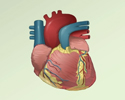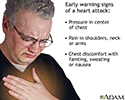Warning signs and symptoms of heart disease
Angina - heart disease warning signs; Chest pain - heart disease warning signs; Dyspnea - heart disease warning signs; Edema - heart disease warning signs; Palpitations - heart disease warning signsHeart disease often develops over time. You may have early signs or symptoms long before you have serious heart problems. Or, you may not realize you are developing heart disease. The warning signs of heart disease may not be obvious. Also, not every person has the same symptoms.
Heart disease
Coronary heart disease is a narrowing of the blood vessels that supply blood and oxygen to the heart. Coronary heart disease (CHD) is also called co...

Certain symptoms, such as chest pain, ankle swelling, and shortness of breath may be signals that something is wrong. Learning the warning signs can help you get treatment and help prevent a heart attack or stroke.
Shortness of breath
Breathing difficulty may involve:Difficult breathing Uncomfortable breathingFeeling like you are not getting enough air

Heart attack
Most heart attacks are caused by a blood clot that blocks one of the coronary arteries. The coronary arteries bring blood and oxygen to the heart. ...

Stroke
A stroke occurs when blood flow to a part of the brain stops. A stroke is sometimes called a "brain attack. " If blood flow is cut off for longer th...

Chest Pain
Chest pain is discomfort or pain that you feel along the front of your body, between (and including) your neck and upper abdomen. There are many causes of chest pain that have nothing to do with your heart.
Chest pain
Chest pain is discomfort or pain that you feel anywhere along the front of your body between your neck and upper abdomen.

But chest pain is still the most common symptom of poor blood flow to the heart or a heart attack. This type of chest pain is called angina or angina pectoris.
Angina
Angina is a type of chest discomfort due to poor blood flow through the blood vessels of the heart muscle. This article discusses how to care for yo...
Read Article Now Book Mark ArticleChest pain can occur when the heart is not getting enough blood or oxygen. The amount and type of pain can vary from person to person. The intensity of the pain does not always relate to how severe the heart problem is.
- Some people may feel a crushing pain, while others feel only mild discomfort.
- Your chest may feel heavy or like someone is squeezing your chest or heart. You may also feel a sharp, burning pain in your chest.
- You may feel the pain under your breastbone (sternum, so the pain is called substernal) or in your neck, arms, stomach, jaw, or upper back.
- Chest pain from angina often occurs with activity or emotion, and goes away with rest or a medicine called nitroglycerin.
- Bad indigestion can also cause chest pain.
Women, older adults, and people with diabetes may have little or no chest pain when they have a heart problem. Some people have symptoms other than chest pain, such as:
- Fatigue
- Shortness of breath
- General weakness
- Change in skin color or greyish pallor (episodes of change in skin color associated with weakness)
Other symptoms of a heart attack can include:
- Extreme anxiety
- Fainting or loss of consciousness
- Lightheadedness or dizziness
- Nausea or vomiting
Nausea or vomiting
Nausea is feeling an urge to vomit. It is often called "being sick to your stomach. "Vomiting or throwing-up forces the contents of the stomach up t...
 ImageRead Article Now Book Mark Article
ImageRead Article Now Book Mark Article - Palpitations (feeling like your heart is beating too fast, too strongly, or irregularly)
- Shortness of breath
- Sweating, which may be very heavy
Shortness of Breath
When the heart can't pump blood as well as it should, blood backs up in the veins that go from the lungs to the heart. Fluid leaks into the lungs and causes shortness of breath. This is a symptom of heart failure (sometimes called congestive heart failure).
Heart failure
Heart failure is a condition in which the heart is no longer able to pump oxygen-rich blood to the rest of the body efficiently. This causes symptom...

You may notice shortness of breath:
- During activity
- While you're resting
- When you're lying flat on your back -- it may even wake you from sleep
Coughing or Wheezing
Coughing or wheezing that doesn't go away can be another sign that fluid is building up in your lungs. You may also cough up mucus that is pink or bloody.
Swelling in the Legs, Ankles, or Feet
Swelling (edema) in your lower legs is another sign of a heart problem. When your heart doesn't work as well, blood flow slows and backs up in the veins in your legs. This causes fluid to build up in your tissues.
You may also have swelling in your stomach or notice some weight gain.
Poor Blood Supply to Extremities
Narrowing of the blood vessels that bring blood to other parts of the body is not the same as heart disease but it may mean you have a much higher risk for heart attack than you otherwise would. It can occur when cholesterol and other fatty material (plaque) build up on the walls of your arteries.
Poor blood supply to the legs may lead to:
Poor blood supply to the legs
Peripheral artery disease (PAD) is a condition of the blood vessels that supply the legs and feet. It occurs due to narrowing of the arteries in the...

- Pain, achiness, fatigue, burning, or discomfort in the muscles of your feet, calves, or thighs.
- Symptoms that often appear during walking or exercise, and go away after several minutes of rest.
- Numbness in your legs or feet when you are at rest. Your legs may also feel cool to the touch, and the skin may look pale.
A stroke occurs when blood flow to a part of the brain stops. A stroke is sometimes called a "brain attack." Symptoms of stroke can include difficulty moving the limbs on one side of your body, one side of the face drooping, loss of sensation on one side of your body, difficulty with speaking or understanding language.
Fatigue
Tiredness can have many causes. Sometimes it simply means that you need more rest. But feeling run down can be a sign of a more serious problem. Fatigue may be a sign of heart trouble when:
- You feel much more tired than normal. It's common for women to feel severely tired before or during a heart attack.
- You feel so tired that you can't do your normal daily activities.
- You have sudden, severe weakness.
Fast or Uneven Heartbeat (Palpitations)
If your heart can't pump blood as well, it may beat faster to try to keep up. You may feel your heart racing or throbbing. A fast or uneven heartbeat can also be a sign of an arrhythmia. This is a problem with your heart rate or rhythm.
Arrhythmia
An arrhythmia is a disorder of the heart rate (pulse) or heart rhythm. The heart can beat too fast (tachycardia), too slow (bradycardia), or irregul...

When to Call the Doctor
If you have any signs of heart disease, contact your health care provider right away. Don't wait to see if the symptoms go away or dismiss them as nothing.
Call 911 or the local emergency number if:
- You have chest pain or other symptoms of a heart attack
- You know you have angina and have chest pain that doesn't go away after 5 minutes of rest or after taking nitroglycerin
- You think you may be having a heart attack
- You become extremely short of breath
- You think you may have lost consciousness
References
Goldman L. Approach to the patient with possible cardiovascular disease. In: Goldman L, Cooney KA, eds. Goldman-Cecil Medicine. 27th ed. Philadelphia, PA: Elsevier; 2024:chap 39.
Gulati M, Bairey Merz CN. Cardiovascular disease in women. In: Libby P, Bonow RO, Mann DL, Tomaselli GF, Bhatt DL, Solomon SD, eds. Braunwald's Heart Disease: A Textbook of Cardiovascular Medicine. 12th ed. Philadelphia, PA: Elsevier; 2022:chap 91.
Morrow DA, de Lemos J. Stable ischemic heart disease. In: Libby P, Bonow RO, Mann DL, Tomaselli GF, Bhatt DL, Solomon SD, eds. Braunwald's Heart Disease: A Textbook of Cardiovascular Medicine. 12th ed. Philadelphia, PA: Elsevier; 2022:chap 40.
Heart attack symptoms - illustration
Symptoms of a heart attack may widely vary, from the classic elephant on the chest feeling of crushing pain, to the nausea and heartburn mistaken for indigestion. In some patients, the symptoms may only be sudden fatigue or an oppressive feeling of impending doom.
Heart attack symptoms
illustration
Heart attack symptoms - illustration
Symptoms of a heart attack may widely vary, from the classic elephant on the chest feeling of crushing pain, to the nausea and heartburn mistaken for indigestion. In some patients, the symptoms may only be sudden fatigue or an oppressive feeling of impending doom.
Heart attack symptoms
illustration
- Heart failure - InDepth(In-Depth)
- Coronary artery disease - InDepth(In-Depth)
- Heart attack and acute coronary syndrome - InDepth(In-Depth)
- Stroke - InDepth(In-Depth)
- Cholesterol - InDepth(In-Depth)
- Diabetes - type 2 - InDepth(In-Depth)
- Exercise - InDepth(In-Depth)
- Chronic obstructive pulmonary disease - InDepth(In-Depth)
- Diabetes - type 1 - InDepth(In-Depth)
- Stroke(Alt. Medicine)
Review Date: 10/15/2024
Reviewed By: Michael A. Chen, MD, PhD, Associate Professor of Medicine, Division of Cardiology, Harborview Medical Center, University of Washington Medical School, Seattle, WA. Also reviewed by David C. Dugdale, MD, Medical Director, Brenda Conaway, Editorial Director, and the A.D.A.M. Editorial team.


